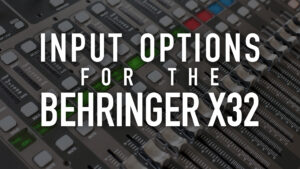I’m often asked what input options we have with the Behringer X32. So today, I am going to dive completely into ALL of the input options that you can use with the Behringer X32.
Inputs
All of the X32 family has the ability to adjust 38 channels of inputs. That is broken into 32 channels of XLR and 6 channels of Aux. I first want to talk about the specific processing which can be utilized in the console inside of the ‘Channels’. Then I will talk about how the ‘Channels’ get the audio from the ‘Inputs’. After that, I will go through how to get the ‘Inputs’ from either the Local X32 or a remote I/O on stage over a digital snake.
Channels 1-32
These are the main channels of the Behringer X32. They can pull audio from any of the inputs on the console. The benefit of these channels is that they have the ability to adjust all of the channel parameters of the channel strip.
- Config Section: Preamp Gain, Low Cut, Input Delay, Polarity, Insert Options
- Gate Section: Gate/Expansion
- Dynamics Section: Compressor/Expansion
- EQ Section: Low Cut + 4 Bands of EQ
- Sends Section: Ability to send to all 16 Mixbusses
- Main Section: Ability to send to LR+Mono Buss or LCR Buss
Aux Channels 1-8
The auxiliary channels of the Behringer X32 can pull audio from any of the inputs just like Channels 1-32, however, we have limited channels parameters which we can now adjust. The Aux channels do not have Low Cut, Input Delay, Insert Points, Gate Section, and the Dynamics Section.
- Config Section: Preamp Gain, Polarity
- EQ Section: 4 Bands of EQ
- Sends Section: Ability to send to all 16 Mixbusses
- Main Section: Ability to send to LR+Mono Buss or LCR Buss
FX Returns 1-4
The FX Return channels are the returns out of the Effect Racks 1-4. These channels can only be sourced from the effects rack. The return has no ability to adjust polarity, gate, or dynamics. However, we do still have the ability to adjust 4 bands of EQ.
- EQ Section: 4 Bands of EQ
- Sends Section: Ability to send to all 16 Mixbusses
- Main Section: Ability to send to LR+Mono Buss or LCR Buss
Routing to the Inputs – Blocks of 8
One limitation of the Behringer X32 line and Midas M32 line is the routing blocks which is labeled ‘Channel Processing Block Patch‘. As you can see in this screenshot of the routing options, they are in blocks of 8.

By default, Input 1-8 is sourced from Local 1-8 so if you plug a microphone into XLR Input 1 on the X32, it will arrive in the Input 1. The default routing options of the channels will also pull from the corresponding number, so Channel 1 will pull from Input 1. We can make the statement that if you plug a microphone into XLR Input 2 on the X32, it will arrive on Channel 2 on the X32.
If you change Input 1-8 to be pulled from AES50 A1-8, you will not be able to access any of the Local 1-8 unless you take up a ‘Block’ from Inputs 9-16, Inputs 17-24, Inputs 25-32, or the Aux In Remap to source from Local 1-8.
Let me give an example of this. We are going to connect a Behringer S32 digital snake into the AES50A port, and swap all Inputs 1-32 to pull from the AES50 A Blocks.
- Input 1-8 > AES50 A1-8
- Input 9-16 > AES50 A9-16
- Input 17-24 > AES50 A17-24
- Input 25-32 > AES50 A25-32
We now have the X32 pulling all audio inputs from the digital snake. If we were to plug a microphone into the Local XLR Input 1 on the back of the X32, we would be unable to access that microphone unless we change one of the ‘Blocks’ back to Local 1-8.
We can use the Aux In Remap to access some of the Local I/O, but that would remove the option to pull from the 1/4 Inch TRS Inputs.
The channels on the board can source from any of the ‘Inputs’ that you choose. So you can have Channel 1 pull from Input 24, but the limitation is that you have the blocks of 8.
If you want a way to circumvent this and have the ability to do 1 to 1 patching, you would need to check out the Behringer X-DANTE or the Klark Teknik DN32-DANTE card along with Dante enabled I/O stage boxes. Which would allow you to 1 to 1 patch through Dante Controller, however remote gain control would be more difficult.
These links below are Affiliate links so purchasing through this link will help support me at no additional cost to you, so thank you!
Consoles of the Behringer X32
Behringer X32 Full Size Console
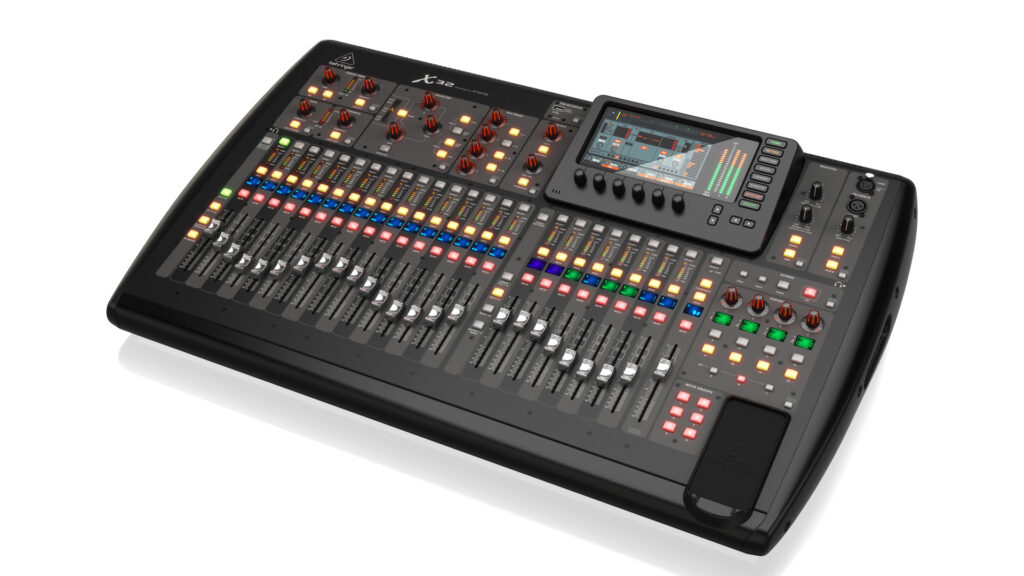
Behringer X32 Full Size Console – This has 32 XLR inputs and 16 XLR outputs built into the console. This is our most commonly found X32 out in the market. The X32 is a great audio console for the price point that it is. It gives us an audio console which has 4 band fully parametric EQ, compression and gate on all 32 channels. There is an Effects Rack which has 8 slots to put everything from reverbs to emulations of classic compressors.
There are 16 mixbusses which can be used as aux sends (16 mono or 8 stereo) with a choice of pre-fader or post-fader, or you can use them as sub-groups. The console also has a Left Right Main Buss and a Center/Mono Buss which can be configured as a LR+M (Left Right + Mono) or an LCR (Left Center Right).
If you route channels into multiple busses and compress those busses differently and then place them back into the LR buss (parallel compression) there will be no time delay issues. You will only fall into an issue if you insert an effect from the Effects Rack on one of the groups where you will find some phasing issues with added delay from the Effects Rack.
The full size X32 has:
- 38 Inputs (32 XLR, 6 1/4 Inch TRS)
- 22 Outputs (16 XLR, 6 1/4 Inch TRS)
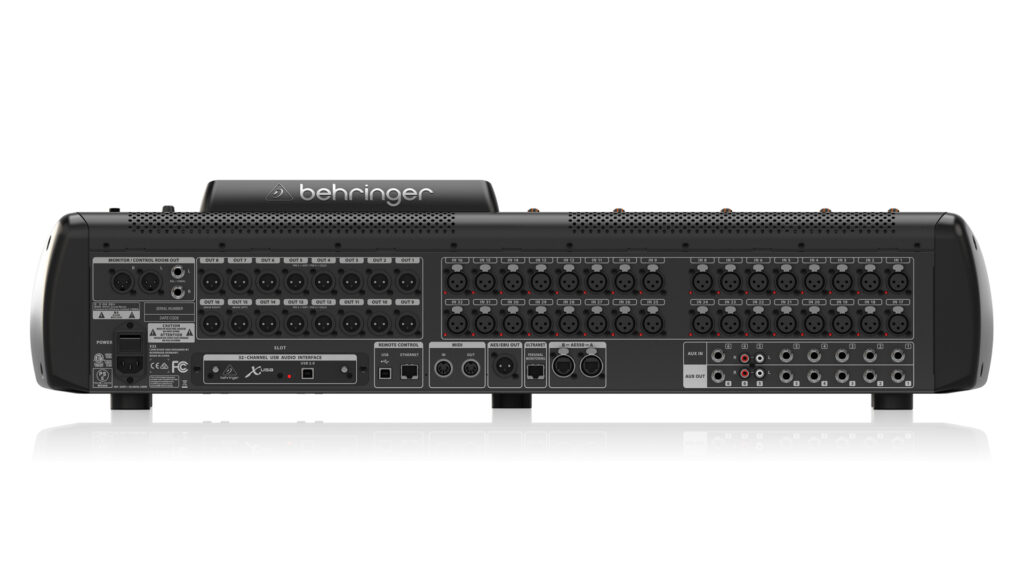
Behringer X32 Compact Console
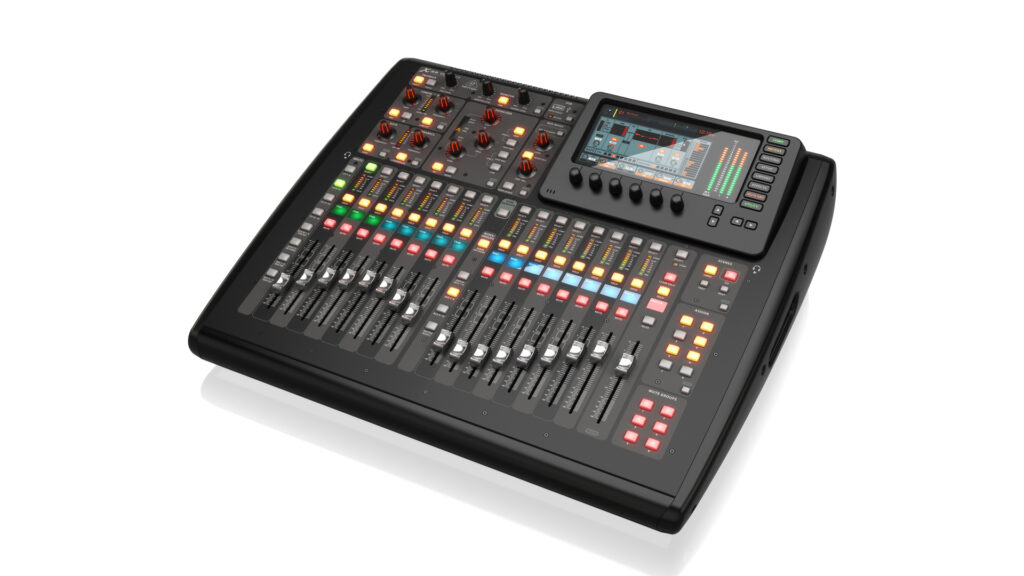
Behringer X32 Compact – The compact version of the X32 removes 8 channel faders still giving us access to the 32 channels, however, it is spread over 4 layers of channels instead of 2. The XLR inputs drop to 16 inputs and the XLR outputs drop to only 8.
- 22 Inputs (16 XLR, 6 1/4 Inch TRS)
- 14 Outputs (8 XLR, 6 1/4 Inch TRS)
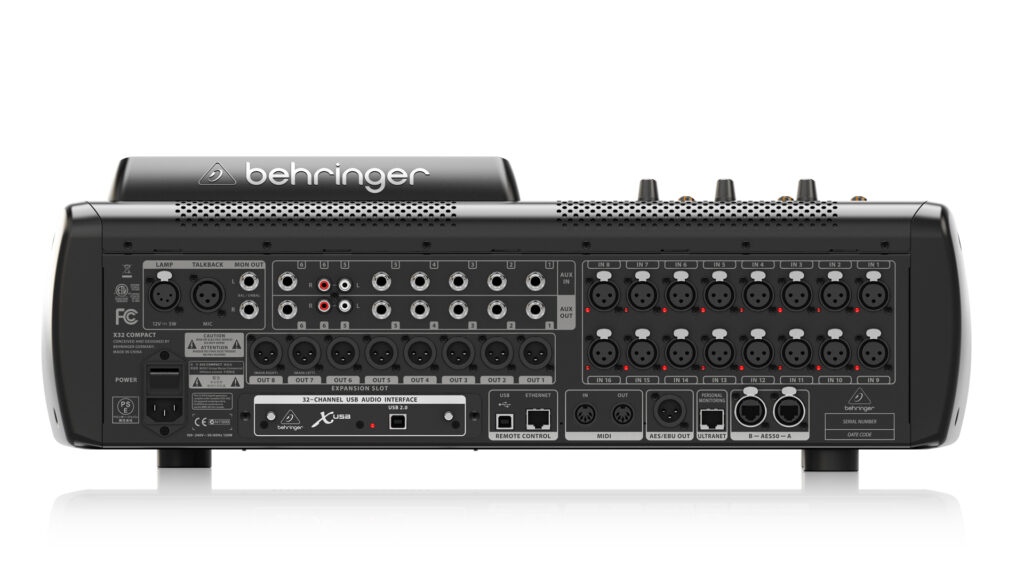
Behringer X32 Producer Console
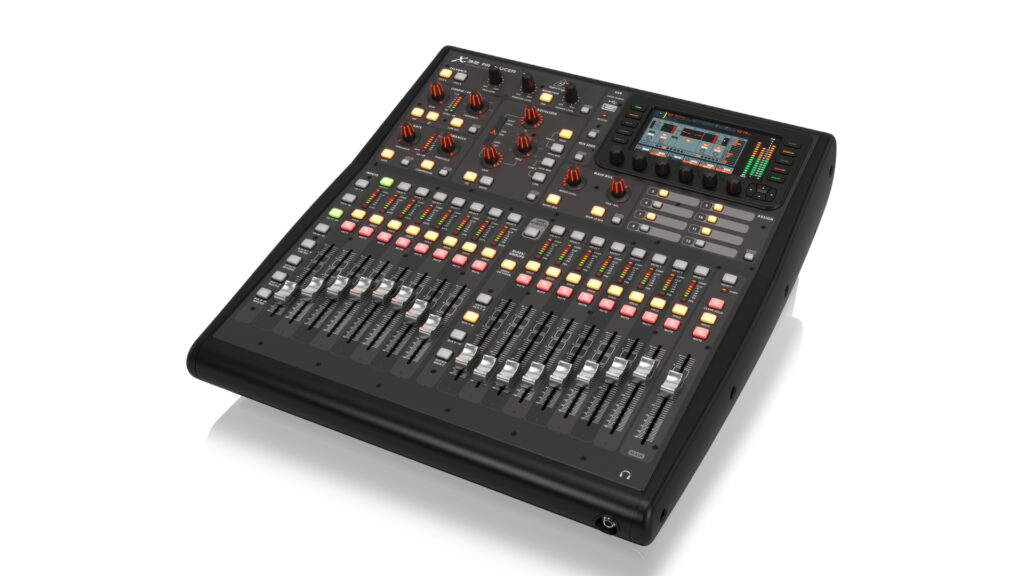
Behringer X32 Producer – Similar to the X32 compact, but the producer gives us a rack-mountable mixer, however, removes the scribble strips. The scribble strips are the little LED windows above the faders which help label the faders you are touching! 16 XLR inputs and 8 XLR outputs on this just like the X32 Compact.
- 22 Inputs (16 XLR, 6 1/4 Inch TRS)
- 14 Outputs (8 XLR, 6 1/4 Inch TRS)

Behringer X32 Rack Console
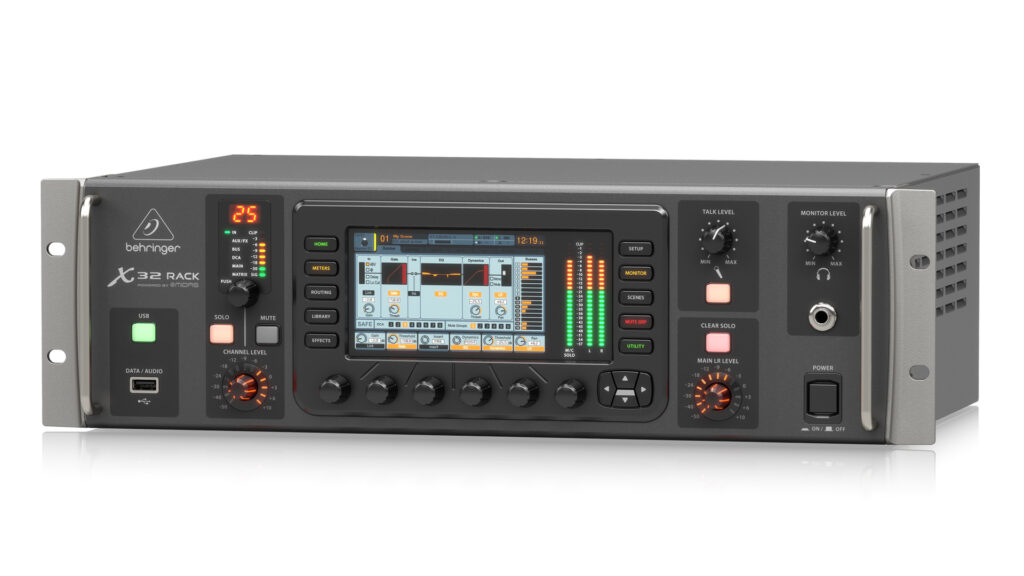
Behringer X32 Rack – The X32 Rack is a rack-mountable 3 RU piece of gear! This is perfect for tossing your X32 into a rolling rack with amplifiers and using the iPad/Android app on your tablet. You have 16 XLR inputs and 8 XLR outputs.
- 22 Inputs (16 XLR, 6 1/4 Inch TRS)
- 14 Outputs (8 XLR, 6 1/4 Inch TRS)

Behringer X32 Core
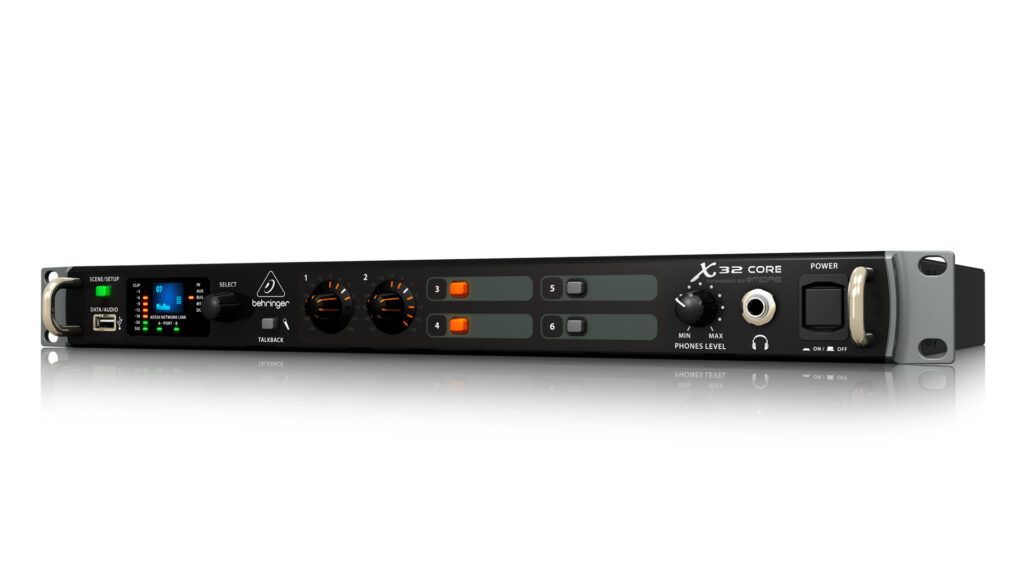
Behringer X32 Core – The X32 Core is a rack-mountable 1 RU piece of gear. It is considered a ‘Legacy Product’ by MUSIC Group and is no longer officially supported (ended support at firmware version 3.11).
Because this doesn’t have much of a front interface, the main use of this product would be through the PC/Mac application X32-Edit or the iPad/Android app on your tablet. This removes all local inputs and outputs aside from a talkback microphone and a monitor LR output which is sourced by the solo.
One benefit of this product is the ability to use it just as an interface to expansion cards. Because of how easy it is to connect multiple X32 products together through AES50, you can have the X32 Core integrate with say the X-USB card for a backup recording interface or other more advanced setups.
- 0 Inputs (There is a single 1/4 Inch TRS for talkback microphone)
- 0 Outputs (There is a monitor LR output, but this does not source from a true bus as this would be interrupted by soloing any channel)
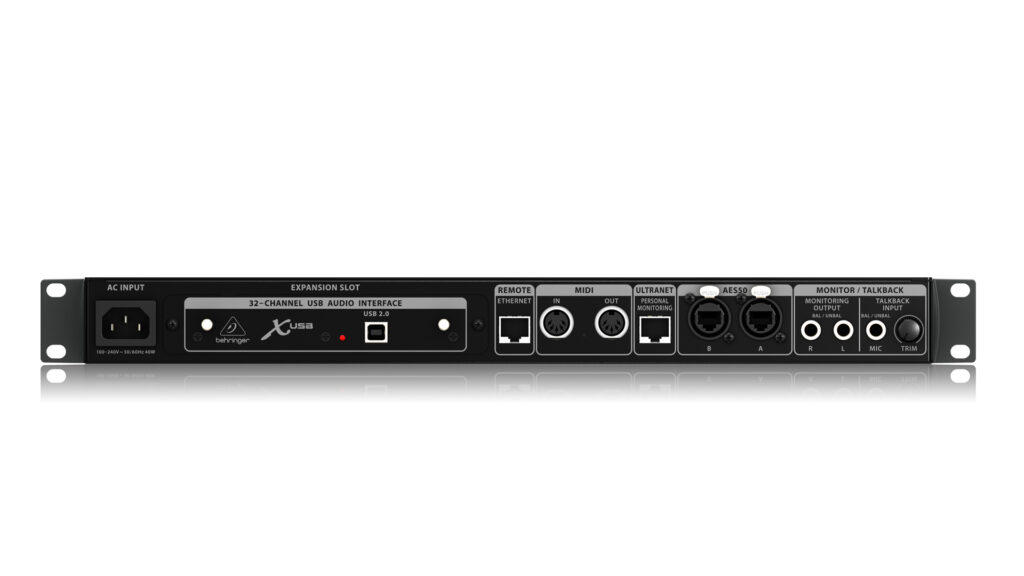
I/O Interfaces for the Behringer X32
The beauty of the Behringer X32 having AES50 is the fact that we can use a Shielded Twisted Pair CAT5e Ethernet cable to connect to remote I/O (inputs and outputs) that are at the stage. AES50 protocol is supported at distances up to 100m and can send and receive 48 channels bi-directionally. This allows for multiple types of configurations.
Connecting Digital Snake to the X32:
When setting up your Behringer X32 to a digital snake box, you will need to press the ‘Routing’ button and tab over to ‘home’. Once you do this you will be able to select from the AES50 A1-32 for the inputs that you choose to pull from the AES50A Port, or the AES50 B1-32 for the inputs coming from the AES50B Port.

Shielded Twisted Pair CAT5e Ethernet – It is required to have a shielded twisted pair (STP) CAT5e ethernet cable or better. The RJ45 connector also needs to be a grounded RJ45 connector. Any UTP cable is not supported and will cause issues with the digital snake connection. It is recommended for robustness that there is an Ethercon Connector at each end of the cable.
Behringer S16 Digital Snake I/O Box
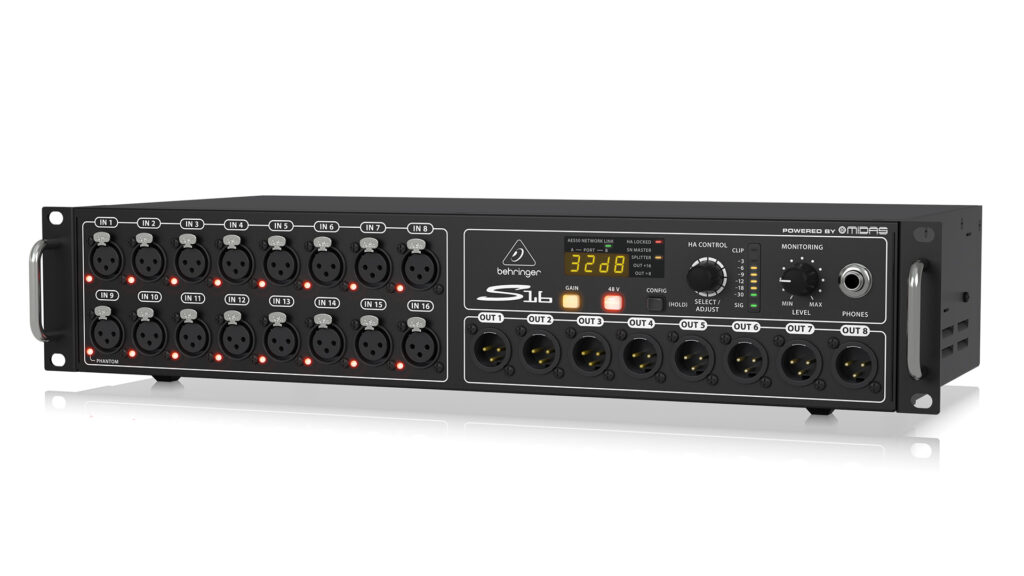
Behringer S16 Digital Snake I/O Box – This is one of the most popular options for remote stage I/O. It has dual AES50 Inputs on the back for a loop through to connect to more I/O on the other side.
For maximum input capability for the X32, you would need to connect two of these remotely bringing your total up to 32 Inputs and 16 Outputs.
- 16 Inputs (16 XLR)
- 8 Outputs (8 XLR)
Behringer S32 Digital Snake I/O Box
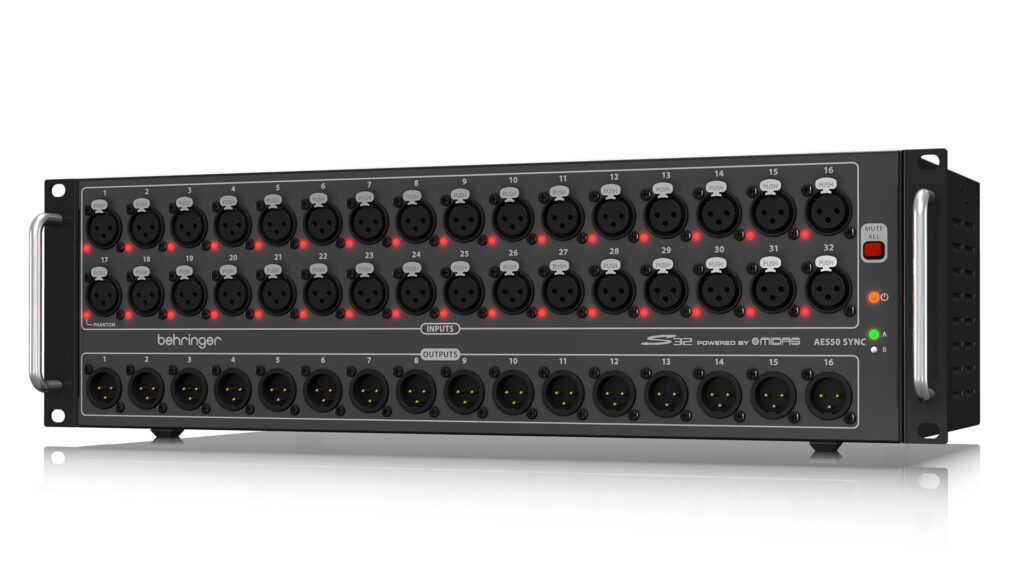
Behringer S32 Digital Snake I/O Box – This is a complete single unit that will give you 32 inputs and 16 outputs remotely for the X32.
- 32 Inputs (32 XLR)
- 16 Outputs (16 XLR)
Behringer SD8 Digital Stage I/O Box
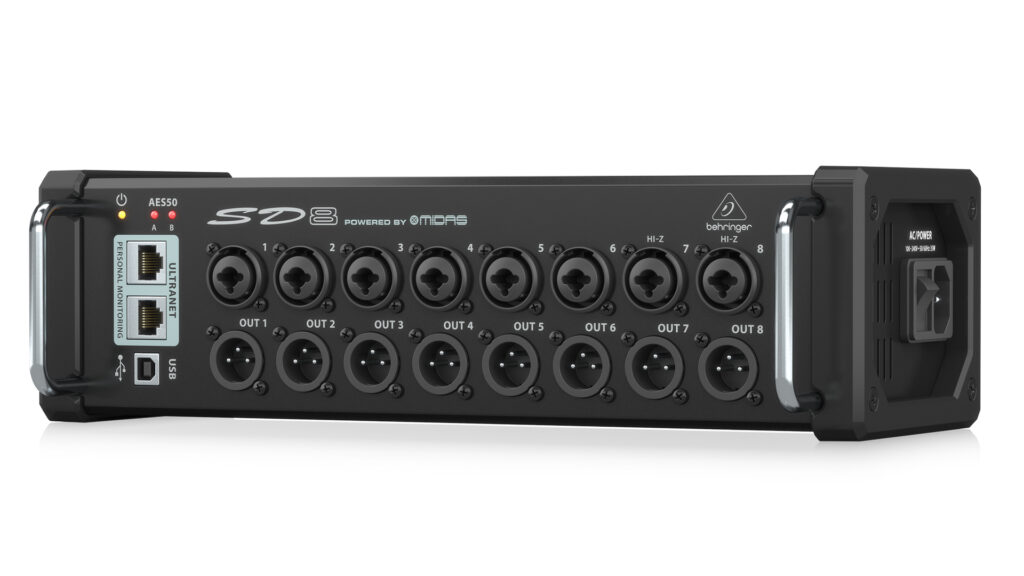
Behringer SD8 Digital Stage I/O Box – The SD series I/O boxes from Behringer I am really excited about. The intention behind these is to be a ‘stage drop’ or ‘sub-snake’ in essence. Having multiple of these on a stage can really simplify your audio line runs as a single STP CAT5e Ethernet cable can run up to 4 of these inline before you take up all of your inputs on the X32.
The other benefit of the SD8 is there are 2 powered Ultranet outputs built into each SD8 unit. These have the power available to run a Behringer P16-M without the wall wart.
- 8 Inputs (8 XLR/TRS combination jack)
- 8 Outputs (8 XLR)
- 2 Powered Ultranet Outputs for P16 Monitoring System

If you are wanting to utilize these in a rackmount box, the rack mount ears are included in the purchase.
Behringer SD16 Digital Stage I/O Box
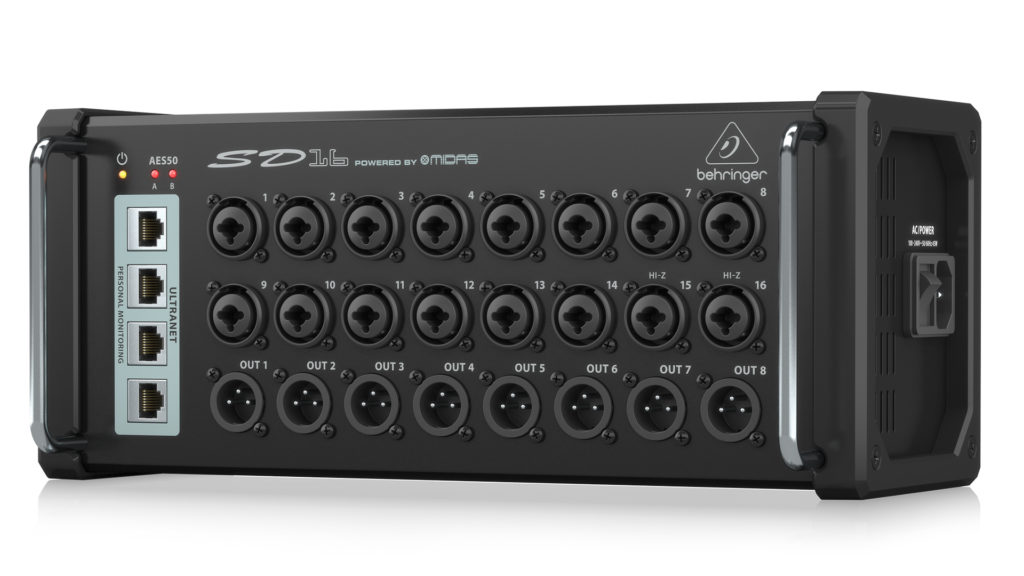
Behringer SD16 Digital Stage I/O Box – This is the larger version of the SD series out of Behringer. You can run multiple configurations/combinations of SD16 and SD8 stage boxes. A single STP CAT5e Ethernet cable can run up to 2 of the SD16’s inline. Or you could run 1 SD16 and 2 SD8 stage boxes in line. The way they are connected does not matter, so you can have the connections look like this:
- SD16 > SD8 > SD8 (32 inputs, 24 outputs)
- SD8 > SD16 > SD8 (32 inputs, 24 outputs)
- SD8 > SD8 > SD16 (32 inputs, 24 outputs)
- SD16 > SD8 (24 inputs, 16 outputs)
- SD8 > SD16 (24 inputs, 16 outputs)
- SD16 > SD16 (32 inputs, 16 outputs)
- SD8 > SD8 > SD8 > SD8 (32 inputs, 32 outputs)
As you can see, there are ways to connect the SD series will bring the output count higher than the X32 will officially support. The X32 will only support Out 1-16 on the XLR’s. You can, however, do a bit of advanced routing utilizing the Ultranet 1-16 portion which will allow you to feed something like the PA. Just remember that there are still only 16 mixbusses on the X32, so even though you increase the number of outputs, you can not increase the number of mixbusses.
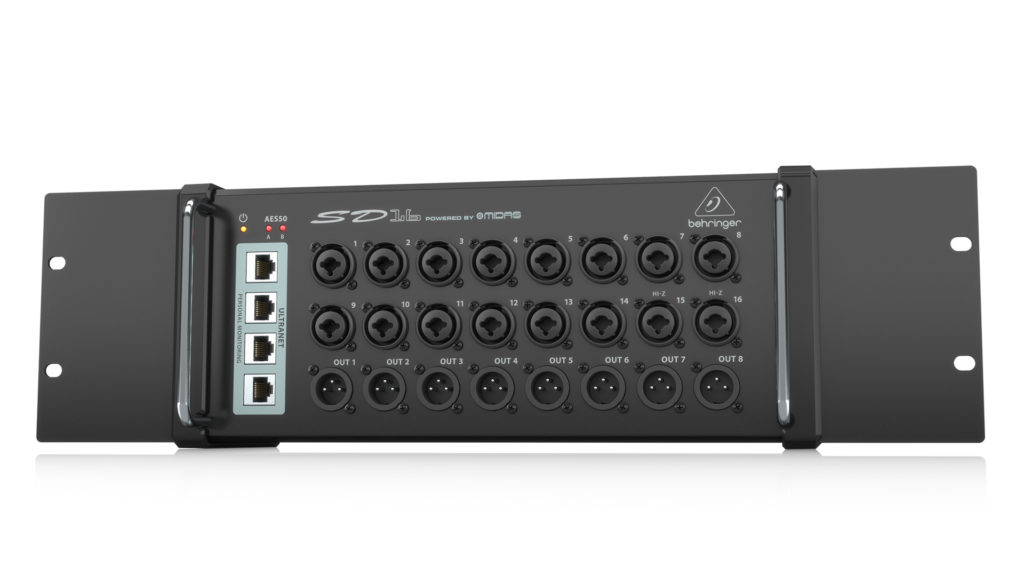
Another benefit of the SD16 is that it has 4 powered Ultranet ports on it to be able to power 4 Behringer P16-M without the wall wart.
- 16 Inputs (16 XLR/TRS combination jack)
- 8 Outputs (8 XLR)
- 4 Powered Ultranet Outputs for P16 Monitoring System
Options for Better Audio Quality
The Behringer X32 family and Midas M32 family can integrate with each other. If you are looking to improve the audio quality of your Behringer X32, you can install Midas stage boxes and instantly have the added sound quality of the true Midas preamps. This is as easy as adding the digital I/O boxes.
Midas DL16 Digital Snake I/O Box
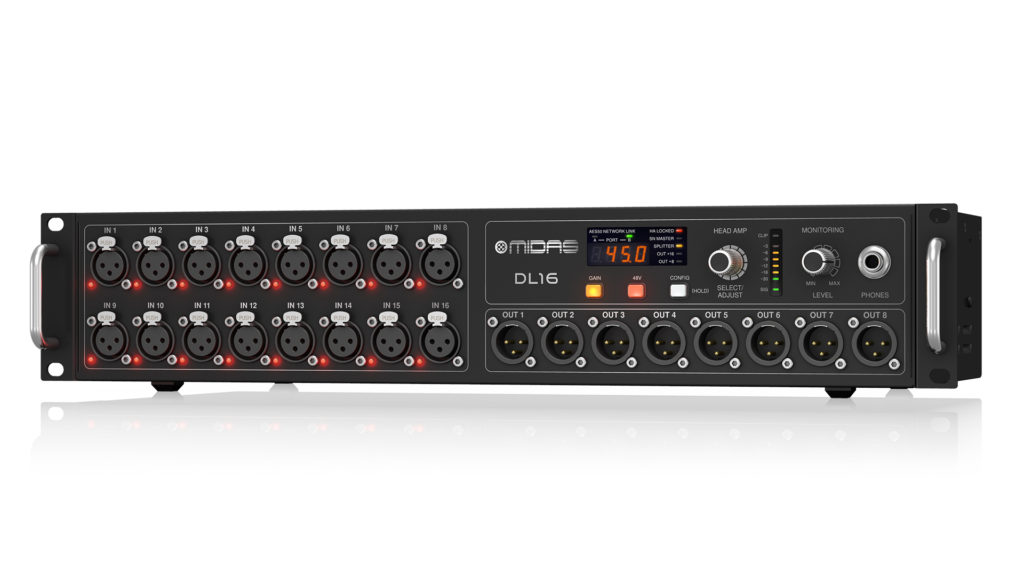
Midas DL16 Digital Snake I/O Box – The Midas DL16 is the smallest channel count I/O box of the M32 family. A single STP CAT5e Ethernet cable can run up to 2 of the SD16’s inline before you max out the M32/X32 inputs/output.
- 16 Inputs (16 XLR)
- 8 Outputs (8 XLR)
Midas DL32 Digital Snake I/O Box
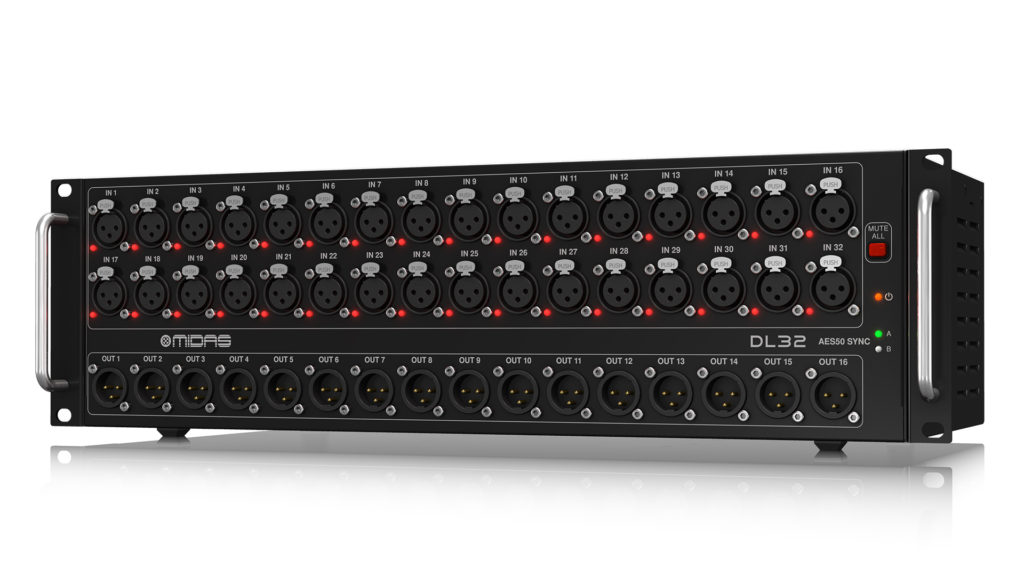
Midas DL32 Digital Snake I/O Box – The Midas DL32 is a full replacement for the X32 with input/output but with the true Midas preamps. This will give you the 32 in and 16 out that your X32 has, but you can have this sitting on stage with your X32 console sitting 100m away.
- 32 Inputs (16 XLR)
- 16 Outputs (8 XLR)
Other Midas Options

Midas DL153 Digital Snake I/O Box – While this is not as easy of an integration as the DL16 or DL32, the DL153 is another option that has become popular in small groups. The problem with using these is the routing of Ultranet is a little more challenging and can cause some headaches if you don’t research before using.
For instance, the DL153 needs to have the outputs that you want showing up on the XLR, to be sent down AES50 17-24.
While these units can be found easily, I would recommend most users stick to the DL16 and DL32 line from Midas for their I/O boxes.
Midas M32 Console

Midas M32 Console – Another option is to just pull all of the inputs from another console! This is possible via the AES50 lines and is quite simple to do. We would, in essence, be pulling all of our inputs from the other console as if it were a stage box.
To do this, set the M32 as the main console all of the inputs will plug into. This console will pull all of the inputs from the Local 1-32. Next, we will want to route all of the Local 1-32 inputs out of the AES50 B Port. Press the ‘Routing’ button and tab over to ‘aes50-b’ tab. Set all of the AES50 B Outputs 1-32 to be from Local 1-32. It should look like this:

To get the X32, connected to the M32, grab an STP CAT5e Ethernet cable and connect it to the AES50 A Port of the X32, and the other end to the AES50 B Port of the M32.
On the X32, we will need to set a few things. First off, under Setup>Global, the Sample Rate will need to match the Midas M32. Next, you will need to set the Synchronization to be from AES50 A.
Once we have this set, we will hit the ‘Routing’ button and pull all of our Inputs 1-32 from the AES50 A Port.

Input Via X32 Expansion Cards
Another option for input and output out of the Behringer X32 family is using the expansion cards as the main I/O. There are some benefits by doing this in some instances and you will have to measure the complexity of setup with a grain of salt. Keep in mind that when you make things more complex, you have the potential of the system being more than a volunteer could handle.
Connecting Expansion Cards to the X32 Inputs:
When setting up your Behringer X32 to an expansion card, you will need to press the ‘Routing’ button and tab over to ‘home’. Once you do this you will be able to select from the Card 1-32 for the inputs that you choose to pull from the Expansion Card.
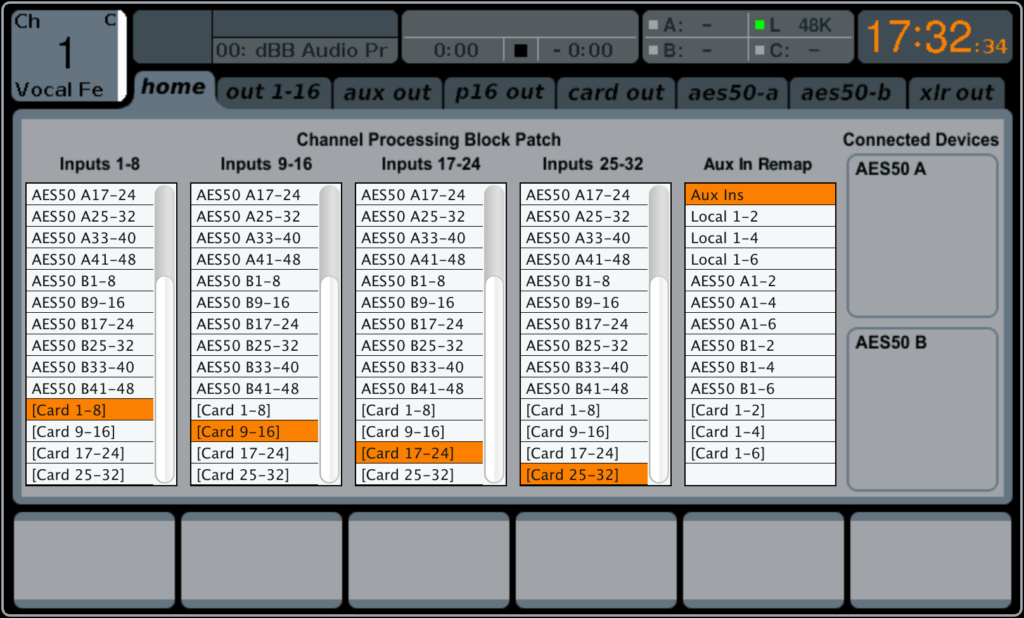
Behringer X-Dante Expansion Card

Behringer X-Dante Expansion Card – The X-Dante card brings some interesting benefits to the X32 family. The main thing that this does, is it brings the ability to do 1 to 1 patching inside of Dante Controller where the X32 and S32/S16 would have to do blocks of 8. You would, of course, need to have some I/O that is Dante enabled like the Yamaha Tio1608 which gives 16 input and 8 output over Dante.
Using Dante, you would also have the X32 integrate with other consoles over Dante. This would be beneficial if you had your main I/O over a different console at FOH and you needed to use the X32 for monitors, you could interface these over Dante.
Klark Teknik DN32-MADI Expansion Card

Klark Teknik DN32-MADI Expansion Card – The DN32-MADI card would give the ability to interface with a lot of different consoles out there. The DN32-MADI card has optical or coaxial connections and would give the ability to interface using the MADI protocol.
This is going to be a much more complex setup, but I can see this being an option to connect the X32 to other consoles like the Avid Venue Profile, D-Show or DiGiCo products.
Klark Teknik DN32-ADAT Expansion Card

Klark Teknik DN32-ADAT Expansion Card – The DN32-ADAT expansion card would give the ability to interface the X32 with any ADAT preamps. It is common to find ADAT devices in recording studios. ADAT preamps will typically be modeled off of classic consoles and have a more nitch market.
Waves X-WSG SoundGrid Expansion Card or Klark Teknik DN32-WSG

Waves X-WSG and Klark Teknik DN32-WSG SoundGrid I/O Expansion Card – The Waves X-WSG card and the Klark Teknik DN32-WSG are the same card and they interface the Behringer X32 with a SoundGrid network. SoundGrid is an extremely stable, extremely low-latency, audio protocol that can be sent to multiple places using SoundGrid certified network gear.
The beauty of this is you could have a Midas M32 at FOH with the X-WSG/DN32-WSG card using MultiRack SoundGrid for Waves Plugins live, and the monitor rig could get the channels over SoundGrid. But it doesn’t stop there, any console connected to SoundGrid could easily interface with the X32 at monitors. So there are a lot of possibilities with the X-WSG/DN32-WSG card.
If you want to read more about the X-WSG/DN32-WSG, I have a few blog posts dedicated to it, which you can read here: LINK.
Behringer X-Air as a Stage Box?
One question that I get every now and then is can the Behringer X-Air series interface with the Behringer X32 as a stage box. The answer is, NO. The X-Air does not interface with the X32 as a stage box. You can set up the X-Air as a separate mixer, and then output the LR mix from the X-Air and place that into the X32 via two analog inputs. This would be called a sub-mixer setup. But you would not be able to control anything on the X-Air from the X32 other than the main LR mix coming into the board.
Conclusion
Thanks so much for spending the time reading this, I have tried to come up with all of the different ways one might connect up X32’s to remote I/O.
